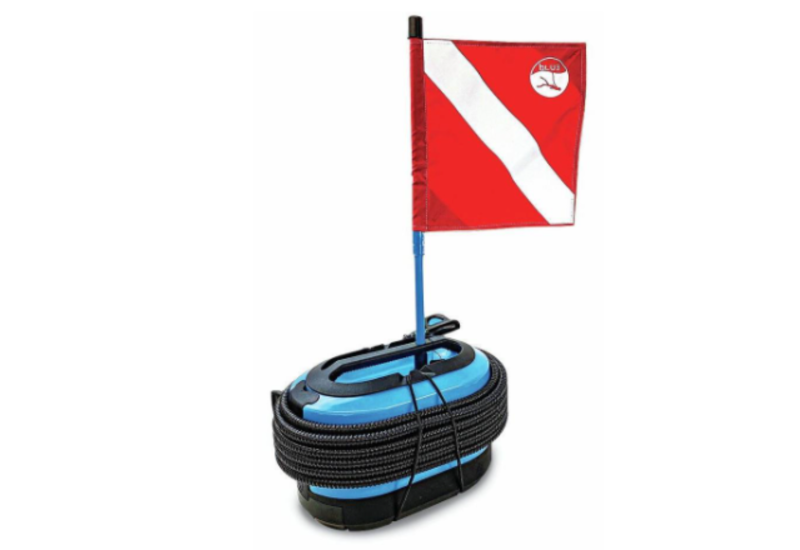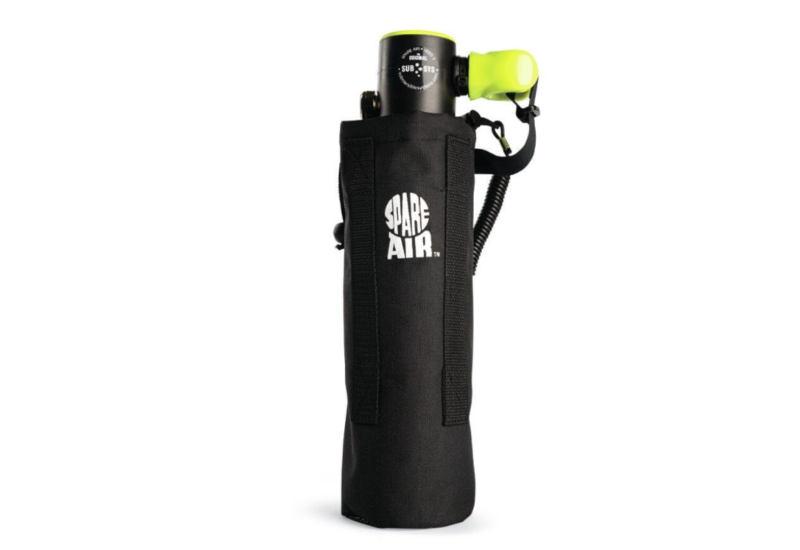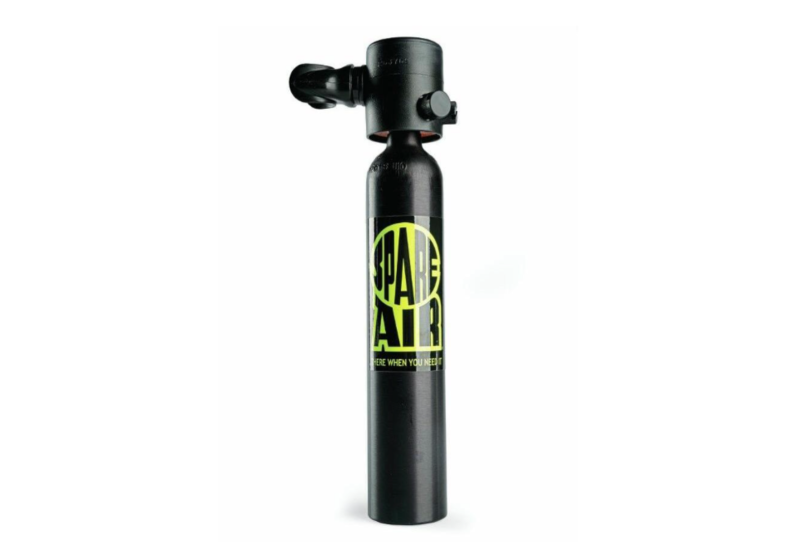Bailout Bottles
Most divers giant stride into the water armed with either a safe-second octopus rig or some sort of BC-integrated alternate air source as part of their gear inventory. Both of these backup breathers are essential in the event your primary second stage malfunctions or your buddy needs to share your air supply. But neither is going to be much help if you suddenly find yourself on the bottom of the ocean strapped to an empty cylinder.
Enter the bailout bottle, a compact, easy-to-use emergency air supply completely independent of your primary tank and regulator. It's designed to do one thing and one thing only--give you a few extra breaths to get to the surface when all else fails.Unlike pony bottle systems, which are much larger and use their own conventional regulator rigs, a bailout bottle is small and simple, consisting of an integrated regulator that screws directly onto a low-volume 3,000 psi bottle. It stows in its own holster that you can attach to a BC strap or anywhere that's handy. It's always "on," so to use it, you simply yank it from its holster, stick it in your mouth, and start kicking like crazy for blue skies.
Since their introduction over two decades ago, bailout bottles have been the subject of much debate. Based on air consumption calculations, opponents argue that the typical bailout bottle is simply too small to get a panicked diver safely to the surface from the deepest recreational depths. But proponents like the insurance of having a completely separate air supply and argue that having even a few extra breaths at your disposal sure beats sucking seawater.So what can these bailout bottles really do for you in an out-of-air situation? To find out, we rounded up three models--two tried-and-true, one relatively new--and went diving. Making 10 dives over the course of three nonconsecutive days, we took each bottle to 132 feet. Upon exhalation, we deployed the bailout bottle and tried to make it to the surface. If a bottle couldn't get us to the surface, we tried progressively shallower depths until it could.
While we strived to simulate a semi-panicked diver in an out-of-air situation, our ascents never exceeded the maximum ascent rates dictated by our dive computers. Plus, we knew that if we sucked the bottles dry, we still had our primary air supply to fall back on, so we may have lacked the same motivation to get to the surface that would grip divers in authentic out-of-air emergencies. So while our findings are not conclusive, we hope this will shed some light on what these bottles can do in a pinch.
SUBMERSIBLE SYSTEMS Spare Air 300
||
|---|
|

|
| SUBMERSIBLE SYSTEMS Spare Air 300|
When most divers think of a bailout bottle, it's the Spare Air that pops to mind. Measuring just over 13 inches tall with a two-and-a-quarter-inch-diameter, three-cubic-foot bottle, Spare Air's Model 300 weighs just over two pounds when full and stows quite compactly in a custom holster that can easily be mounted on your BC cummerbund or tank strap.
The Spare Air uses a balanced, single-stage, integrated regulator that screws directly onto the bottle. Work of breathing is not as good as a traditional regulator, but the compact bottle and the holster system make it easy to deploy one-handed. Once the rig is in your mouth, you don't need to hold onto the bottle. The Spare Air 300 was able to easily get our test divers from 70 feet to the surface with about half a dozen additional surface breaths to spare.Spare Air's Model 300 fills off your primary cylinder via a yoke adapter. There's also a fitting that allows it to be filled directly from a fill station or compressor. A built-in pressure indicator nub protrudes when the bottle is full, and sits flush when the bottle is less than half full. A dial pressure gauge is available as an option.
The Spare Air 300 sells for $299. Price includes a three-cubic-foot bottle with single-stage reg, a built-in pressure indicator, a yoke-style adapter for filling off a scuba tank, a storage holster and safety lanyard. The Model 300 is also available in a nitrox version. Spare Air has a one-year warranty.
SUBMERSIBLE SYSTEMS Spare Air 170
||
|---|
|

|
| SUBMERSIBLE SYSTEMS Spare Air 170|
This is the original bailout bottle, introduced back in 1979. It's the same as the Model 300 except for its smaller package. Standing less than nine inches tall with a two-and-a-quarter-inch-diameter, 1.7-cubic-foot bottle, the 170 weighs only 1.5 pounds when full and easily stows just about anywhere you can attach its holster. Because of its super-compact size, the Model 170 is a favorite among traveling divers who prefer to dive with a little added insurance.
The Spare Air 170 was able to easily get test divers from a depth of 45 feet to the surface with about half a dozen surface breaths to spare. It sells for $299 and comes with a 1.7-cubic-foot bottle with single-stage reg, a built-in pressure indicator, an adapter for filling off a scuba tank, a storage holster, a safety lanyard and a one-year warranty. A dial gauge pressure indicator is optional.
H2ODYSSEY Extra Air Source
The six-cubic-foot EAS was the only bailout bottle we tested that was able to get us from 132 feet (maximum recommended recreational diving depth) to the surface, and it did so with more than a dozen additional surface breaths to spare. Of course, standing over 13 inches tall with a three-inch-diameter cylinder that weighs five pounds when full, it's also the largest bailout bottle we tested, and probably about as big as you'd want to carry around without moving into pony bottle territory.
||
|---|
|

|
| H2ODYSSEY Extra Air Source|
What makes the EAS unique is its regulator system, which uses a conventional second stage connected to a balanced piston first stage via a horizontal/vertical swivel. The swivel enables you to maintain a comfortable breathing position regardless of the angle of the bottle. The EAS delivers the kind of easy breathing performance you'd expect from your primary second stage. This performance no doubt contributed to the system's air efficiency on our ascents. When full, the EAS is just slightly negative, so it hangs out of the way and is surprisingly easy to use with no hands. Indeed, there were times we forgot we were breathing off a bailout bottle and not our primary reg. However, because of the swivel, sometimes you need to hold the bottle with one hand and steady the second stage with the other before inserting it into your mouth. Also, the bottle gets buoyant as it nears empty. At this point, you need to hold onto the bottle; otherwise, the swivel allows the bottle to float up in front of your face.
The EAS fills directly off your primary cylinder via a yoke-style adapter. There's also a fitting that allows it to be filled directly from a fill station or compressor. The EAS sells for $299, which includes the six-cubic-foot bottle with first and second stages plus connecting swivel. Options include the adapter for filling off a scuba tank, a holster and a dial pressure gauge. It has a two-year warranty.
Most divers giant stride into the water armed with either a safe-second octopus rig or some sort of BC-integrated alternate air source as part of their gear inventory. Both of these backup breathers are essential in the event your primary second stage malfunctions or your buddy needs to share your air supply. But neither is going to be much help if you suddenly find yourself on the bottom of the ocean strapped to an empty cylinder.
Enter the bailout bottle, a compact, easy-to-use emergency air supply completely independent of your primary tank and regulator. It's designed to do one thing and one thing only--give you a few extra breaths to get to the surface when all else fails.Unlike pony bottle systems, which are much larger and use their own conventional regulator rigs, a bailout bottle is small and simple, consisting of an integrated regulator that screws directly onto a low-volume 3,000 psi bottle. It stows in its own holster that you can attach to a BC strap or anywhere that's handy. It's always "on," so to use it, you simply yank it from its holster, stick it in your mouth, and start kicking like crazy for blue skies.
Since their introduction over two decades ago, bailout bottles have been the subject of much debate. Based on air consumption calculations, opponents argue that the typical bailout bottle is simply too small to get a panicked diver safely to the surface from the deepest recreational depths. But proponents like the insurance of having a completely separate air supply and argue that having even a few extra breaths at your disposal sure beats sucking seawater.So what can these bailout bottles really do for you in an out-of-air situation? To find out, we rounded up three models--two tried-and-true, one relatively new--and went diving. Making 10 dives over the course of three nonconsecutive days, we took each bottle to 132 feet. Upon exhalation, we deployed the bailout bottle and tried to make it to the surface. If a bottle couldn't get us to the surface, we tried progressively shallower depths until it could.
While we strived to simulate a semi-panicked diver in an out-of-air situation, our ascents never exceeded the maximum ascent rates dictated by our dive computers. Plus, we knew that if we sucked the bottles dry, we still had our primary air supply to fall back on, so we may have lacked the same motivation to get to the surface that would grip divers in authentic out-of-air emergencies. So while our findings are not conclusive, we hope this will shed some light on what these bottles can do in a pinch.
SUBMERSIBLE SYSTEMS Spare Air 300
|| |---|
|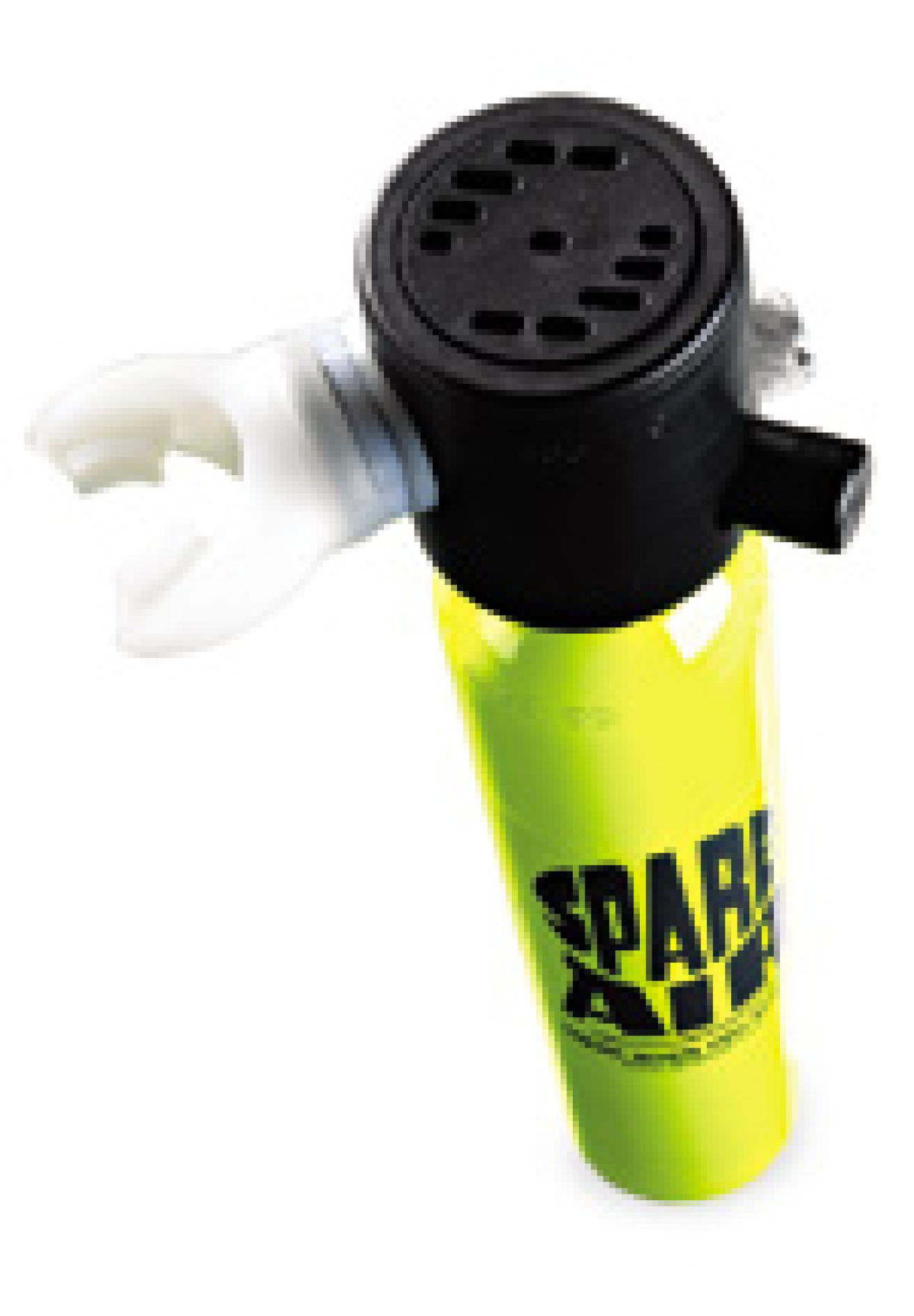
| | SUBMERSIBLE SYSTEMS Spare Air 300|
The Spare Air uses a balanced, single-stage, integrated regulator that screws directly onto the bottle. Work of breathing is not as good as a traditional regulator, but the compact bottle and the holster system make it easy to deploy one-handed. Once the rig is in your mouth, you don't need to hold onto the bottle. The Spare Air 300 was able to easily get our test divers from 70 feet to the surface with about half a dozen additional surface breaths to spare.Spare Air's Model 300 fills off your primary cylinder via a yoke adapter. There's also a fitting that allows it to be filled directly from a fill station or compressor. A built-in pressure indicator nub protrudes when the bottle is full, and sits flush when the bottle is less than half full. A dial pressure gauge is available as an option.
The Spare Air 300 sells for $299. Price includes a three-cubic-foot bottle with single-stage reg, a built-in pressure indicator, a yoke-style adapter for filling off a scuba tank, a storage holster and safety lanyard. The Model 300 is also available in a nitrox version. Spare Air has a one-year warranty.
SUBMERSIBLE SYSTEMS Spare Air 170
|| |---|
|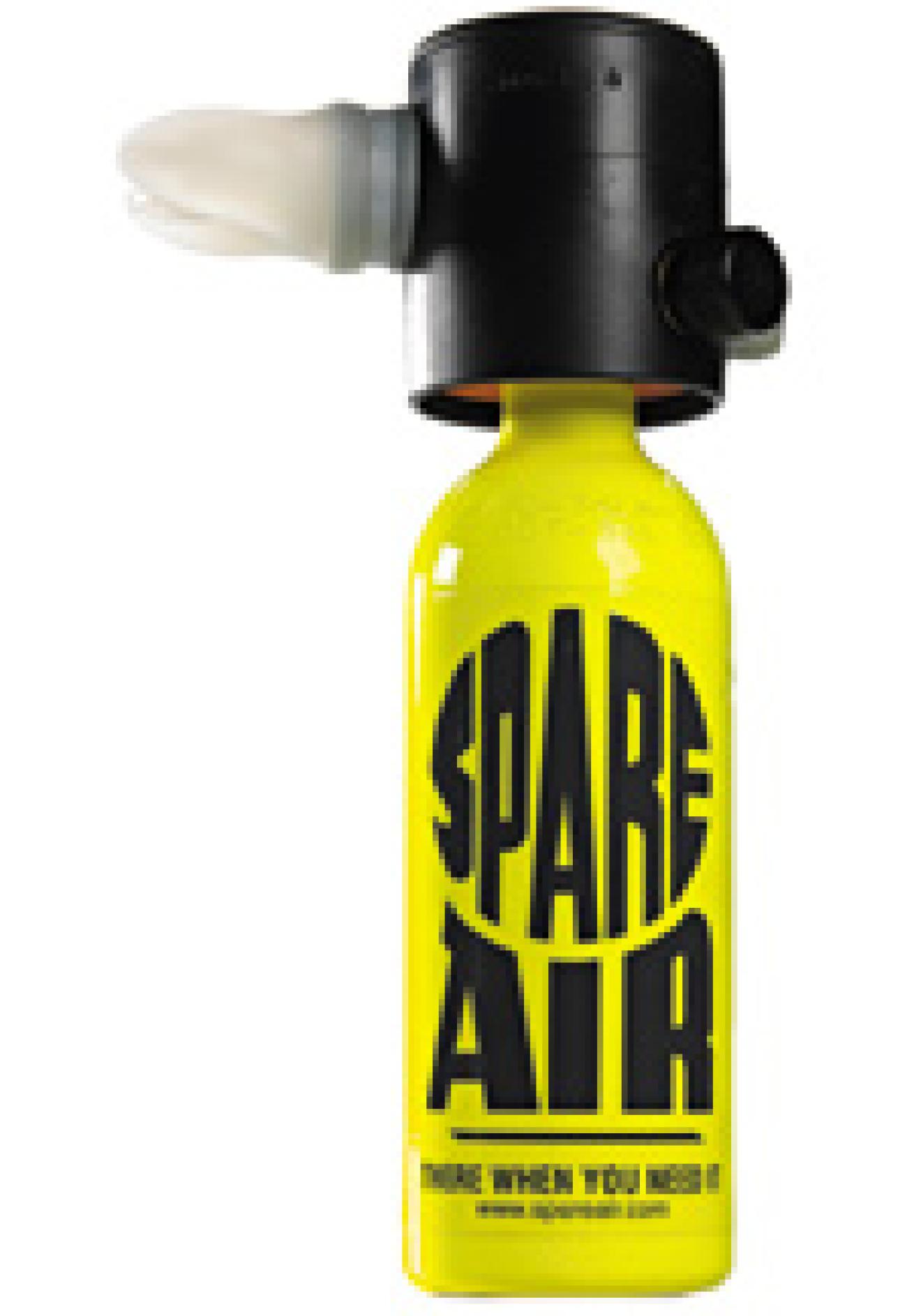
| | SUBMERSIBLE SYSTEMS Spare Air 170|
The Spare Air 170 was able to easily get test divers from a depth of 45 feet to the surface with about half a dozen surface breaths to spare. It sells for $299 and comes with a 1.7-cubic-foot bottle with single-stage reg, a built-in pressure indicator, an adapter for filling off a scuba tank, a storage holster, a safety lanyard and a one-year warranty. A dial gauge pressure indicator is optional.
H2ODYSSEY Extra Air Source
The six-cubic-foot EAS was the only bailout bottle we tested that was able to get us from 132 feet (maximum recommended recreational diving depth) to the surface, and it did so with more than a dozen additional surface breaths to spare. Of course, standing over 13 inches tall with a three-inch-diameter cylinder that weighs five pounds when full, it's also the largest bailout bottle we tested, and probably about as big as you'd want to carry around without moving into pony bottle territory.
|| |---|
|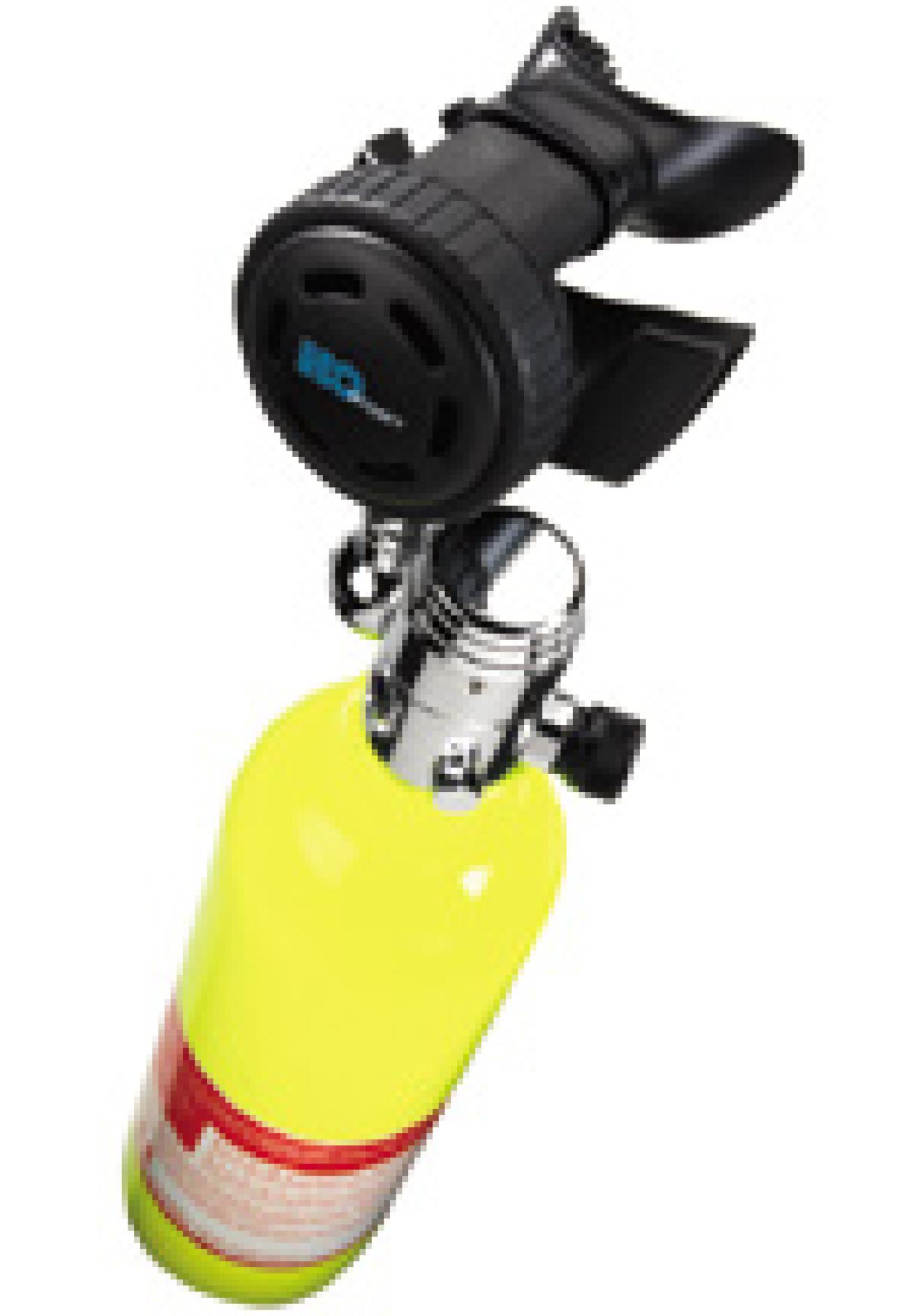
| | H2ODYSSEY Extra Air Source|
The EAS fills directly off your primary cylinder via a yoke-style adapter. There's also a fitting that allows it to be filled directly from a fill station or compressor. The EAS sells for $299, which includes the six-cubic-foot bottle with first and second stages plus connecting swivel. Options include the adapter for filling off a scuba tank, a holster and a dial pressure gauge. It has a two-year warranty.


